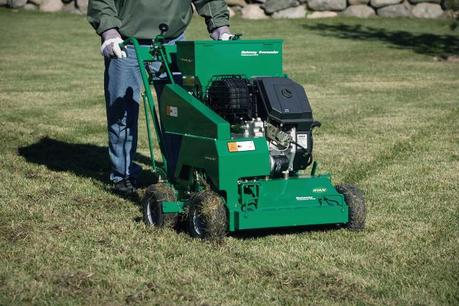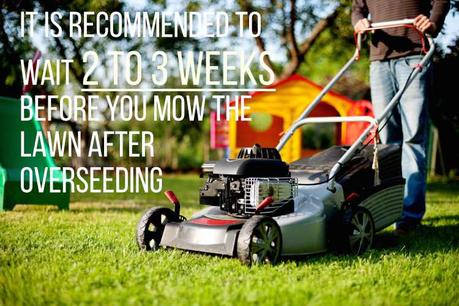As a part of the gardening world, you already know that not only is proper maintenance essential for a successful lawn, but timing as well. That being said, in this article, we’ll provide you with the answer to one of the most common gardening questions – what is the ideal time for mowing after overseeding?
Overseeding is a straightforward process. However, there are several things you need to pay attention to before and after you sow the seeds to ensure successful growth.
Initial Mowing
Right before overseeding, lightly dethatch the current grass and mow it significantly short, 1-1/2 inches, that is. This way, you prevent the grass and weeds from competing with the new seedlings for water and nutrients.
Overseeding

Planting new grass seed directly into existing turf without tearing it up is known as overseeding. So, if your lawn looks old, or there are bare spots to fix, overseeding will do the job. Choose the right grass seed type and spread over the parts of the lawn you want to thicken. Also, make sure to aerate simultaneously for better results. There are some pretty neat aerators that make this a seamless process.
Watering Before Mowing
Soil moisture is crucial for successful germination. But then again, the seeds require moist but not soggy soil to thrive. Hence, during the first two weeks, water the overseeded areas twice a day, or even more under dryer conditions, soaking the top ¼ inch of the soil.
Mowing after Overseeding

The grass will suffer stress when mowed; hence, the best thing to do after overseeding is to give it a rest. So, when to cut the grass after overseeing?
In general, it’s recommended to wait for at least 2 to 3 weeks before mow overseeded lawn. This way, you’ll allow the new seeds to settle and put down roots. But then again, it all depends on the type of grass you’ve sown.
Each type of grass has a different germination speed. Consequently, the time each type of grass takes to reach mowable length varies. However, follow the rule of thumb when mowing – that is, never remove more than 1/3 of the total grass blade length at a single cutting. For this reason, you also need to know what’s the ideal height of your turf and to allow it to grow 1/3 longer before mowing.
With that said, take a look at the optimal height of each grass species separately.
Warm-Season Grasses
Bahia2.5 – 4 inches
Bermuda0.5 – 2.5 inches
Buffalo1.5 – 4 inches
Centipede1 – 2.5 inches
Kikuyu Grass1 – 1.5 inches
St. Augustine1 – 3 inches
Zoysia0.5 – 3 inches
Cool-Season Grasses
Fine Fescue1.5 – 4 inches
Kentucky Bluegrass0.75 – 3.5 inches
Perennial ryegrass0.75 – 2.5 inches
Tall Fescue1.5 – 4 inches
Tip: To reduce seedling injury, mow when the grass is dryFAQs
The best time for overseeding the lawn is late summer or early fall when the temperatures are most favorable for optimum seed germination. When provided with adequate moisture, nutrients, and sunlight, the grass seedlings will be established before the temperatures drop.
It’s essential to mow the grass short prior to overseeding because, otherwise, it’ll compete with the new seedlings for the same resources, inhibiting their growth. This way, you’ll also prevent the seed from lodging in tall grass, while allowing the sunlight to reach the new seedlings.
The grass seed will sprout when just thrown on the ground. However, it’ll have a negative effect on its germination and growth when planted in this fashion. To ensure success, you should plant and maintain it properly. Speaking of which, preparing the seedbed before planting, covering the seed with soil once planted, adding fertilizer, and watering are just a few out of many steps you should take to get a healthy lawn.
Bahia2.5 – 4 inches
Bermuda0.5 – 2.5 inches
Buffalo1.5 – 4 inches
Centipede1 – 2.5 inches
Kikuyu Grass1 – 1.5 inches
St. Augustine1 – 3 inches
Zoysia0.5 – 3 inches




